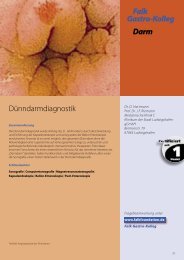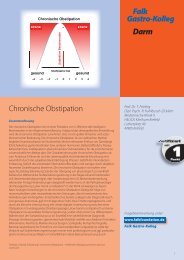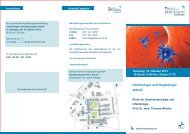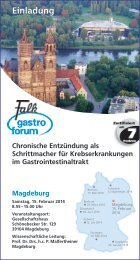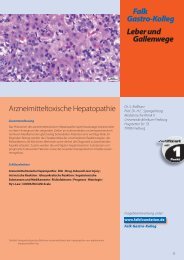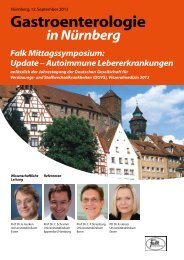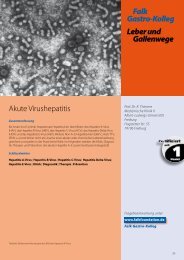152 153 Intestinal Disease Meeting Berlin 2006 - Dr. Falk Pharma ...
152 153 Intestinal Disease Meeting Berlin 2006 - Dr. Falk Pharma ...
152 153 Intestinal Disease Meeting Berlin 2006 - Dr. Falk Pharma ...
Create successful ePaper yourself
Turn your PDF publications into a flip-book with our unique Google optimized e-Paper software.
Session 1<br />
Congress Short Report <strong>Falk</strong> Symposium <strong>153</strong><br />
<strong>Falk</strong> Symposium <strong>153</strong><br />
Immunoregulation in Inflammatory Bowel <strong>Disease</strong>s –<br />
Current Understanding and Innovation<br />
<strong>Berlin</strong>, May 6–7, <strong>2006</strong><br />
Advances in the Pathogenesis<br />
of IBD<br />
Chair:<br />
A. Dignass, Frankfurt<br />
D. Rachmilewitz, Jerusalem<br />
Inflammatory bowel diseases:<br />
strong genetic components<br />
Inflammatory bowel diseases (IBD) such as<br />
Crohn’s disease (CD) and ulcerative colitis (UC)<br />
usually manifest themselves in adolescents or<br />
young adults. Their incidence has been increasing<br />
over the past decades and, according to<br />
S. Schreiber (Kiel), it occurs more frequently in<br />
some families. This, together with the high concordance<br />
in monozygotic twins (over 55%),<br />
which is not observed in fraternal twins (under<br />
5%), supports the hypothesized strong genetic<br />
component of these diseases.<br />
IBD are polygenetic diseases, although recent research<br />
has identified the NOD2 (CARD15) gene<br />
that potentially acts as a trigger in the pathogenesis<br />
of Crohn’s disease (figure 18). According to<br />
S. Schreiber, NOD2 belongs to a large family of<br />
S. Schreiber<br />
proteins involved in defending the organism from<br />
bacterial invasion. “NOD2, however, is not by<br />
far the only component of the pathomechanism<br />
of inflammatory bowel diseases,” S. Schreiber<br />
said. Corresponding mutations are involved in<br />
the disease process in less than half of all patients<br />
(figure 19), which means that the search must<br />
continue for further potential pathogenetic<br />
factors.<br />
Like NOD2, some other factors may involve chromosome<br />
16, on which several areas have been<br />
identified that may be involved in the development<br />
of IBD. Here, S. Schreiber said, gene splicing<br />
may play a role. This process, in which RNA<br />
fragments of varying length and corresponding<br />
protein fragments are produced, lends high<br />
plasticity to the human genome.<br />
27



